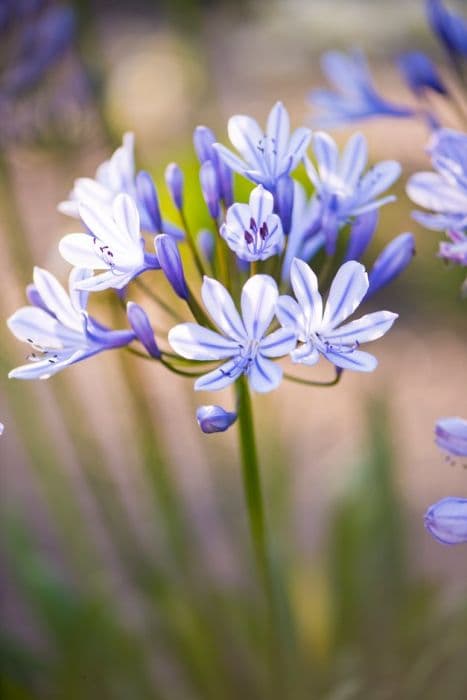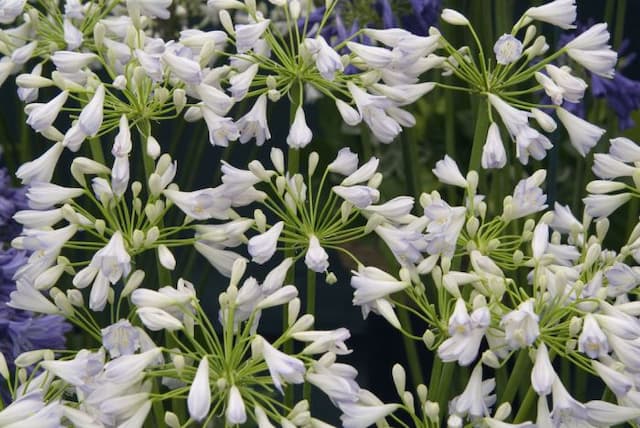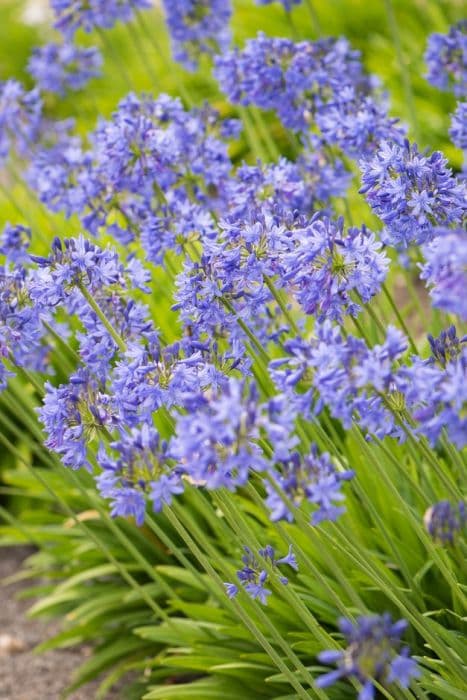Lily of the Nile Agapanthus 'Sweet Surprise'

ABOUT
The Agapanthus 'Sweet Surprise' is an eye-catching perennial known commonly as Lily of the Nile. This plant boasts lush, strap-shaped green leaves that form a dense clump, creating a rich backdrop for its stunning floral display. The most striking feature of Agapanthus 'Sweet Surprise' is its globular clusters of flowers, known as umbels, which float atop sturdy, upright stems, giving the appearance of delicate spheres suspended gracefully above the foliage. Each umbel is composed of numerous trumpet-shaped flowers, which present a soft color palette, transitioning from bud to bloom with varying shades of blue and purple accentuated by subtle hints of white. These blossoms are arranged in a way that resembles fireworks frozen in time, contributing to the plant's allure in garden settings. The flowers of Agapanthus 'Sweet Surprise' are particularly known for their long-lasting nature, both on the plant and as cut flowers in floral arrangements, attracting both visual admirers and pollinators like bees and butterflies. The overall appearance of the plant exudes a refined yet vibrant quality, making it a favorite for ornamental purposes in gardens and landscapes.
About this plant
 Names
NamesSynonyms
African Lily, Lily of the Nile, Love Flower.
Common names
Agapanthus 'Sweet Surprise'.
 Characteristics
CharacteristicsLife cycle
Perennials
Foliage type
Evergreen
Color of leaves
Green
Flower color
Lavender
Height
2 feet (60 cm)
Spread
2 feet (60 cm)
Plant type
Bulb
Hardiness zones
8
Native area
South Africa
Benefits
 General Benefits
General Benefits- Ornamental appeal: Agapanthus 'Sweet Surprise' offers attractive globe-shaped clusters of blue or purple flowers that can enhance the aesthetic of gardens and landscapes.
- Drought tolerance: Once established, it is relatively drought-resistant, making it suitable for gardens in drier climates or for water-wise landscaping.
- Low maintenance: This plant requires minimal care beyond occasional watering and deadheading, making it a convenient choice for busy gardeners.
- Long blooming period: 'Sweet Surprise' has a long flowering season from late spring to summer, providing prolonged color and interest in the garden.
- Attracts pollinators: The blooms can attract bees, butterflies, and other beneficial insects, promoting biodiversity.
- Use in cut flower arrangements: The long stems and showy blooms make 'Sweet Surprise' an excellent choice for fresh floral arrangements.
- Border and container gardening: It's well-suited for use in borders and as a container plant due to its clumping habit and striking flowers.
- Perennial growth: As a perennial, it returns year after year, offering lasting value in the landscape.
 Medical Properties
Medical PropertiesThis plant is not used for medical purposes.
 Air-purifying Qualities
Air-purifying QualitiesThis plant is not specifically known for air purifying qualities.
 Other Uses
Other Uses- African Lily, or Agapanthus 'Sweet Surprise', can be used as a blue dye source for fabrics and textiles. The flowers can be crushed to make a natural dye.
- Used in floral art, the sturdy and long stems of the African Lily make it an excellent flower for arrangements and bouquets.
- The robust leaves of the African Lily can be used in small scale weaving projects, such as making decorative baskets or mats.
- Agapanthus stalks can be dried and used as natural skewers for holding together or adding decorative touch to finger foods in garden parties.
- They can act as a living mulch in the garden, with the dense root system of African Lily plants helping to retain soil moisture and prevent weed growth.
- The seed pods of the African Lily can be used in dried flower arrangements or as an inclusion in potpourri for their interesting shape and texture.
- The African Lily can be placed in ponds or water gardens as floating decorations because of their long-lasting cut flowers that can survive in water for some time.
- Biomimicry inspiration could be derived from the African Lily's flower structure, potentially influencing design in areas such as water-collection systems or architectural elements.
- In photography, the striking appearance of the African Lily, with its globular flower clusters, offers an excellent subject for practicing macro and depth-of-field techniques.
- The sap of African Lily can be used as a natural adhesive in small scale or emergency repairs of paper or other light materials.
Interesting Facts
 Feng Shui
Feng ShuiThe Agapanthus, commonly known as Lily of the Nile, is not used in Feng Shui practice.
 Zodiac Sign Compitability
Zodiac Sign CompitabilityThe Lily of the Nile is not used in astrology practice.
 Plant Symbolism
Plant Symbolism- Love Letters: Agapanthus is sometimes known as the "love flower," which could symbolize a message or a declaration of love.
- Beauty: With its striking blue flowers, Agapanthus is often associated with beauty and a stunning appearance.
- Endurance: The Agapanthus can tolerate various conditions, representing endurance and the ability to withstand challenges.
- Fertility: In some cultures, Agapanthus is seen as a symbol of fertility and creation due to its lush and bountiful floral displays.
 Water
WaterLily of the Nile requires consistent moisture during the growing season. Water deeply once a week, providing about one to two gallons of water to ensure the soil is moistened to a depth of 5 to 6 inches, but be careful not to overwater as it dislikes soggy conditions. During the winter, when the plant is dormant, reduce watering significantly, only moistening the soil if it becomes very dry. In hotter climates or during particularly hot spells, it may require more frequent watering. Monitor the soil moisture regularly; the surface should begin to dry out before the next watering.
 Light
LightLily of the Nile thrives in full sun to partial shade conditions. The ideal spot for this plant is a location where it can receive at least six hours of direct sunlight per day. However, in extremely hot climates, afternoon shade can help protect the plant from excessive heat, which might otherwise stress it or burn the foliage.
 Temperature
TemperatureLily of the Nile prefers a temperate climate with temperatures ranging between 60°F and 90°F for optimal growth. This plant can tolerate a minimum temperature down to about 50°F for short periods; however, if the temperature drops below this, it is at risk of frost damage. During the winter in colder zones, it is best to protect the plant or bring potted specimens indoors.
 Pruning
PruningPruning Lily of the Nile is mainly done to remove spent flower stalks and to tidy up the plant. Deadheading the flowers after they fade encourages additional blooms. Cut back the foliage in late winter or early spring before new growth starts, which helps to rejuvenate the plant. Pruning is typically required once a year but inspect the plant seasonally for any damaged or diseased parts that may need removal.
 Cleaning
CleaningAs needed
 Soil
SoilThe best soil mix for African Lily (Agapanthus 'Sweet Surprise') should be well-draining, rich in organic matter with a loamy texture. The soil pH should ideally be slightly acidic to neutral, ranging from 6.0 to 7.0. A mixture of garden soil, compost, and perlite or coarse sand is recommended to ensure proper drainage and fertility.
 Repotting
RepottingAfrican Lilies should be repotted every 2 to 3 years or when they become root-bound. Over time, Agapanthus 'Sweet Surprise' can outgrow its container, indicating a need for repotting to ensure continued growth and blooming.
 Humidity & Misting
Humidity & MistingAfrican Lilies prefer moderate humidity levels. They can thrive well in the average humidity found in most homes or gardens, without the need for special humidity considerations.
 Suitable locations
Suitable locationsIndoor
Place African Lily in bright, indirect light indoors.
Outdoor
Plant African Lily in partial sun to full sun outside.
Hardiness zone
8-11 USDA
 Life cycle
Life cycleAgapanthus 'Sweet Surprise,' commonly known as Lily of the Nile, starts its life as a seed that germinates in moist, well-drained soil, typically in spring or early summer. Once germinated, the seedling develops into a young plant with strap-shaped leaves, forming a clump that gradually matures over the course of several years. During the growth phase, the plant increases in size and stores energy in its rhizomatous root system to support future blooms. After reaching maturity, typically within 2-3 years, Lily of the Nile produces tall, sturdy stalks topped with rounded clusters of trumpet-shaped flowers, varying in shades of blue, purple, or white during the summer months. After flowering, seed pods may form, which can be harvested for propagation or left to self-seed in conducive growing conditions. Lastly, in fall or when temperatures drop, the plant enters a period of dormancy where growth slows and the above-ground foliage may die back, especially in cooler climates, before resurging in spring.
 Propogation
PropogationPropogation time
Spring-Early Summer
Propogation: Agapanthus 'Sweet Surprise', commonly known as Lily of the Nile, is best propagated by division, a process typically done in the spring or early fall. The most popular method involves carefully digging up the clump of the plant and gently separating the rhizomes, ensuring that each division has at least one or two growing points or shoots. These divisions are then replanted at the same soil depth from which they were taken, spaced about 12 to 18 inches (approximately 30 to 45 centimeters) apart to allow room for growth. It's essential to water the newly planted divisions well, maintaining consistent moisture without waterlogging the soil, to help establish the roots. Through division, the Lily of the Nile will continue to thrive and produce its characteristic blue or purple flowers, making it a delightful addition to any garden.









